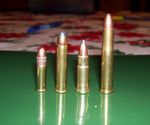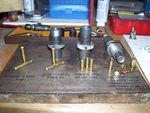Due to it's diminutive size it might be best called a "Kittycat".
I have an antique Pinfire revolver that I want to get shooting and, finding no suitable modern ammo, I have come up with this "pea-shooter" round. The parent case is .22 Hornet.
I have bored out the old rotten bore on the revolver and will sleave it to .22 cal. I am going to attempt to machine a complete new cylinder out of modern steel and chamber it for my new little round.
The goal is to get cast bullets flying at about Long Rifle velocities. This project should keep me busy for several weeks at least.
Left to right,,, 22 LR, 22 Mag,?, and 22 Hornet


|
   
   
|


|



 Reply With Quote
Reply With Quote











